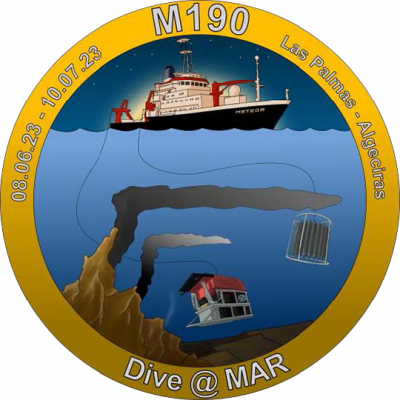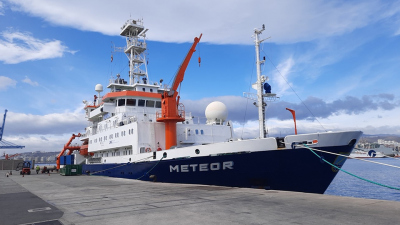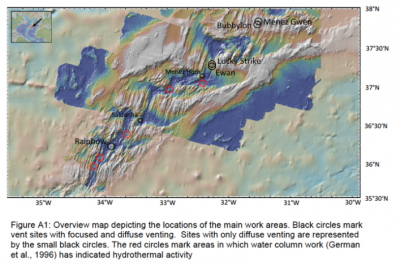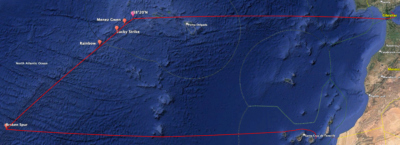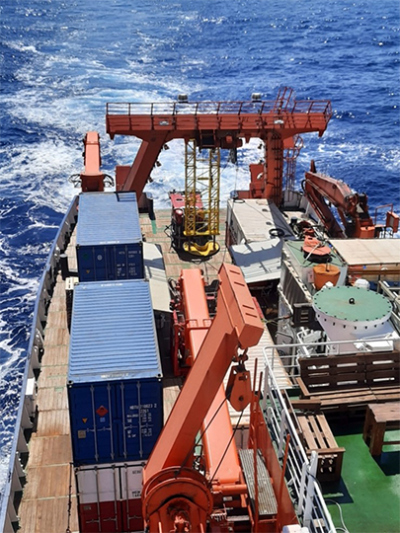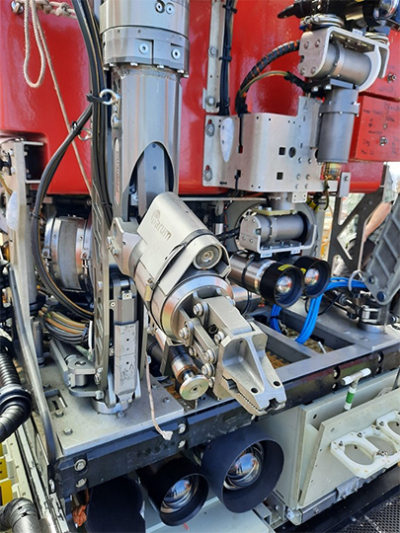- Home
- Discover
- Ship's logs
- Ship's log M190
Ship's log M190
FS METEOR on course for the Mid-Atlantic Ridge
No two black smokers are alike - this applies to the geology as well as to the fluids that emerge from the hydrothermal vents. Now an approximately four-week research cruise is starting, led by Prof. Wolfgang Bach from MARUM. The aim of the expedition with the research vessel METEOR is to investigate differences between the individual vents and discharge points. This applies both to the chemical composition of the escaping fluids and to the geological framework conditions. In addition, the microorganisms living here, which live either freely or in symbioses at the smokers, will also be studied.
From June 8 to July 10, the 28-member expedition team will also go in search of previously unknown hydrothermal vents, in addition to already known hydrothermal vents. On board will be the diving robot MARUM-QUEST 4000 as well as other scientific equipment for detecting and sampling hydrothermal plumes, i.e. the "plumes" of hot springs.
The target area is the Mid-Atlantic Ridge south of the Azores. Expedition M 190 is expected to provide key results for the Cluster of Excellence "Ocean Floor" based at MARUM, especially in the question of how geosphere and biosphere interact with each other on the ocean floor.
Here, the researchers report on their experiences aboard RV METEOR.
Livestream of the dives of the ROV MARUM-QUEST
The transmission technology is highly dependent on the conditions at sea. Therefore, dives can be canceled or postponed at short notice.
Join the live dives of the ROV MARUM-QUEST.
The next dive will be announced here.
08 June 2023 - [Bitte aktivieren Sie Javascript]
The German research vessel R/V METEOR left the harbor of Las Palmas de Gran Canaria this morning. Aboard is a science team composed of geologists, biologists, geochemists and oceanographers, and including seven members of the MARUM ROV-team. The scientific goal of METEOR cruise M190, entitled “Dive@MAR” (Distribution of Venting Along the Mid-Atlantic Ridge (29-38°N) and Implications for Hydrothermal Exchange and vent Ecosystems), is to develop an understanding of the processes at hydrothermal vents along the Mid-Atlantic Ridge between 29 and 38° North and in water depths between 3,100 and 800 meters.
The cruise is organized and carried out by the Cluster of Excellence (EXC) "Ocean Floor" of MARUM – Center for Marine Environmental Sciences of the University of Bremen. In the EXC, scientists from the University of Bremen, the Constructor University Bremen and the Bremen Max Planck Institute for Marine Microbiology are united in the research of hydrothermal vents. In addition, scientists from the University of the Azores and the University of Lyon, Göttingen and Münster as well as the Federal Institute for Geosciences and Natural Resources in Hanover are involved in the M190 project. Many data will already be gathered during the cruise. But for the final picture to emerge, the countless samples to be collected in the coming weeks will have to be exposed to detailed studies in the labs onshore.
09 June 2023 - The Mid-Atlantic Ridge
Day 2 - the R/V METEOR sails along a westerly course on its way to the submarine hydrothermal vent systems at the Mid-Atlantic Ridge. From Las Palmas to our first working area, a distance of 1,500 nautical miles has to be covered. At 10 nautical miles per hour, we have a bit over six days of transit before reaching our first study site. Time to look at some details.
The Mid-Atlantic Ridge (MAR) is part of the longest mountain range on Earth. With a total length of around 60,000 km, these so called mid-ocean ridges are found in all oceans. Here is where the major tectonic plates of Earth spread apart and new seafloor forms. In the northern Atlantic Ocean, the plates spread apart at rates of 2-3 cm/year, thereby enlarging the distance between Europe and North America. Most of this seafloor is composed of basaltic rocks that form when the upper mantle comes up underneath the MAR and undergoes partial melting. This upflow of the mantle happens in response to the divergent movement of the plates along the MAR. Because hot material of relatively low densely moves up underneath the MAR, the seafloor rides higher there than elsewhere in the middle of the Atlantic. This crest of MAR lies between 2,500 and 3,500 m water depth. Away from the ridge crest, crust and mantle cool and turn denser, which causes the seafloor to subside to water depths > 4,000 to 5,000 m in the deep-sea basins on either side of the MAR.
Along with the movement of basaltic magma that fills the gap between the diverging plates tremendous amounts of heat are brought to the seafloor. This high heat flow initiates the circulation of seawater through the newly formed and highly fractured ocean floor. Cold seawater percolates through cracks in between the rocks of the ocean floor, where it is heated up. Interactions with hot rocks in the basement change the chemical composition and physical properties of the circulating seawater which is turned into a hot fluid, with temperatures as high as 400°C and more! These fluids are enriched in a variety of dissolved metals, sulfide, and different gases. They rise up quickly through cracks in the ocean floor and are injected into the oceans through hydrothermal vents. Upon contact with the 2°C-cold sea water, the dissolved metals and sulfide immediately precipitate as minerals, which form tall chimney structures at the seafloor. Most of the minerals, however, are expelled from the top of the chimneys into the ocean as black smoke, forming particle plumes that rise to hundreds of meters above the seafloor before the spread out sideways.
10 June 2023 - Vent fauna
The laboratories are fully readied for the first samples to come in. The biologists come particularly well equipped. Perhaps this is then a good time to talk about the vent fauna, which the geological processes described before allow to exist. Fascinating and diverse oases of life are developed in the vicinity of the hydrothermal vents. The base of the food-web in deep-sea vent ecosystems is not photosynthesis; instead, microbes use chemical energy stored in metals, sulfide and gases dissolved in the hot fluids to turn carbon dioxide into biomass. These microbes can be free living, forming mats that cover the ocean floor, or they live in symbiosis with mussels and other animals that are part of a uniquely adapted vent fauna.
The first submarine hydrothermal vent system was discovered in the eastern Pacific in 1977. Since then, more than 120 hydrothermal vents have been investigated in all parts of the world’s oceans. Goal of research cruise M190 is to visit four working areas between 29 and 38°N along the Mid-Atlantic Ridge: Broken Spur, Rainbow, Lucky Strike and Menez Gwen. These sites are well known to all who study hydrothermal vents. Yet, much is still to discover, and the entire science team is eager to reach the first working area. Until then, the scientists install the equipment they brought along in the ship’s laboratories. The science party includes engineers, chemists, biologists, and geologists with diverse goals and agendas. Daily science meetings foster the exchange between the diverse groups aboard. We’ll report about the different science questions and approaches used to answer them in forthcoming blogs.
11 June 2023 - Where Meteor-Bank gets its name from
Today, we are crossing the Meteor-Bank, a very large, flat-toped seamount which represents the remains of a large volcanic island. After the volcanic activity had ceased, erosion wore down the exposed volcano to sea-level where a wide wave-cut platform formed. As eluded to before, cooling of the plate causes the seafloor to subside. This is why the wave-cut platform is now 300 m below sea-level. The surrounding seafloor is >4000 m deep. Meteor Bank was named to honor the vessel used for the cruise that discovered this large table-mountain in the middle of the Atlantic: the first R/V METEOR.



